IKLAN
Kamis, 11 April 2013
Sabtu, 06 April 2013
JOGJAKARTA TOURISM OBJECT
Baron beach
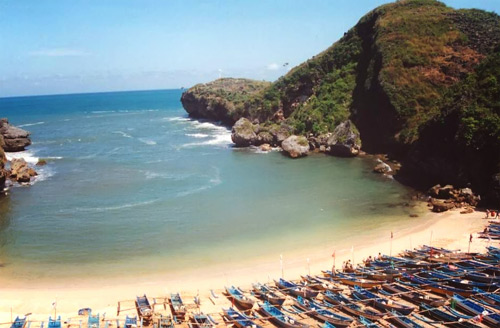 Baron beach lies in Kemandang Village, Tanjungsari district
about 23 km in the South of Wonosari city. Baron beach is the first
beach that would be found in the junction of Baron, Kukup, Sepanjang,
Drini, Krakal and Sundak beaches area. It is a bay with big wave. Baron
beach is popular as fish catching area. There is a mouth of Underground
River that can be used for bathing after playing in the beach. The
visitors can also enjoy various kinds of low prices seafood or fresh
fish and Baron's special menu namely Kakap fish soup. There is limestone
hill in this area. The visitors can reach that place by passing through
a path. The way to go there is very interesting because it passes a
place called Pegunungan Seribu (a thousand mountains).
Baron beach lies in Kemandang Village, Tanjungsari district
about 23 km in the South of Wonosari city. Baron beach is the first
beach that would be found in the junction of Baron, Kukup, Sepanjang,
Drini, Krakal and Sundak beaches area. It is a bay with big wave. Baron
beach is popular as fish catching area. There is a mouth of Underground
River that can be used for bathing after playing in the beach. The
visitors can also enjoy various kinds of low prices seafood or fresh
fish and Baron's special menu namely Kakap fish soup. There is limestone
hill in this area. The visitors can reach that place by passing through
a path. The way to go there is very interesting because it passes a
place called Pegunungan Seribu (a thousand mountains).Visitors could have a magnificent view of the beach; about 10 kilometers in the West of Baron beach there are Parang Racuk hill with its mountain slopes. It challenged the visitors to do some adventures. Every syuro month (the first month of Javanese calendar), the fisherman societies organized a Labuhan sea ceremony, to express their gratitude to the God for the abundant fish harvest and for the welfare in fishing.
Kukup beach
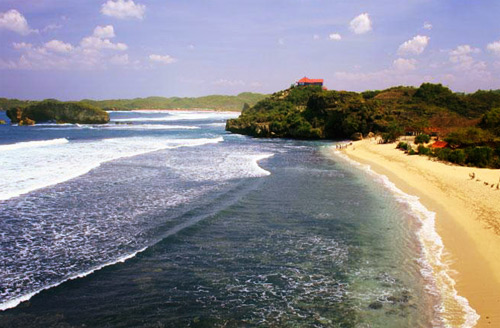 Kukup Beach is a white sandy beach lies in Kemadang village,
Tanjungsari district, about 1 km away in the east of Baron beach. It has
a pathway trough the hill up to Baron beach and also a coral island,
which is connected by a senggol bridge. Kukup Beach, grey black sand
dunes, treacherous ocean currents and jagged rocks. This beach is
located near Baron Beach, only 1 km east.
Kukup Beach is a white sandy beach lies in Kemadang village,
Tanjungsari district, about 1 km away in the east of Baron beach. It has
a pathway trough the hill up to Baron beach and also a coral island,
which is connected by a senggol bridge. Kukup Beach, grey black sand
dunes, treacherous ocean currents and jagged rocks. This beach is
located near Baron Beach, only 1 km east.Kukup beach is rich in sea life and also famous of its various kinds of beautiful fish in sea aquarium or various kinds of beautiful fishes that sold by the merchants along the beach. There are hall (pendopo), cottage and other facilities in this area. Just like in Baron beach, this beach also performs a sea offering ceremony every Syuro. Kukup Beach, see from the Rock Hill Island with a gazebo, at the east part of the areas can access with climb a several set of natural staircase through the bridge along to the rock island.
Krakal beach
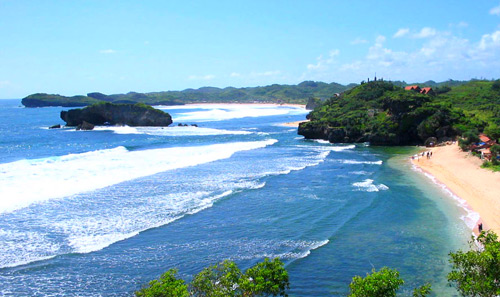 Go to the next beach, about 6 kilometers from Kukup beach, we
will find Krakal beach- a white sand beach stretch along 5 kilometers.
Krakal beach the longest beach of the junction is located in Ngestirejo
village, Tanjungsari district, about 3 km away in the east of
Baron-Kukup-Sepanjang-Drini beach junction, has scratching white hill
with blue slopes gently to the sea. The beauty of green lime-scratching
hill with blue seawater offers a perfect harmony, which is very natural
and ideal for sun bathing. Krakal beach mostly is a white sandy beach in
Yogyakarta area. There's a development now because of its beautiful
panorama of the southern sea. It should be careful here because it has
big wave and the texture of the beach which are rocks meet the sands.
Go to the next beach, about 6 kilometers from Kukup beach, we
will find Krakal beach- a white sand beach stretch along 5 kilometers.
Krakal beach the longest beach of the junction is located in Ngestirejo
village, Tanjungsari district, about 3 km away in the east of
Baron-Kukup-Sepanjang-Drini beach junction, has scratching white hill
with blue slopes gently to the sea. The beauty of green lime-scratching
hill with blue seawater offers a perfect harmony, which is very natural
and ideal for sun bathing. Krakal beach mostly is a white sandy beach in
Yogyakarta area. There's a development now because of its beautiful
panorama of the southern sea. It should be careful here because it has
big wave and the texture of the beach which are rocks meet the sands.Among all the beaches that stretch along Java beaches, Krakal with its white sandy beach surrounded with mountainous rocky hills is the most beautiful one. Krakal is close to Kukup beach and Baron cove. This cove is in fact an estuary of an underground river that comes up exactly at the waterfront. It is interesting to observe the combination of the beach and the cove from the protruding rocky hills that flank the caves on both sides.
Parangtritis Beach
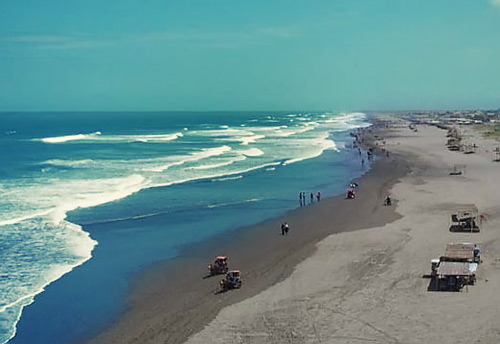 One of the attractive beaches near Yogyakarta is Parangtritis.
It is located about 27 km. from Yogyakarta, Parangtritis may be reached
in two ways, through Kretek Village or the longer one but more well -
established road through Imogiri and Siluk Village. Parangtritis Beach
is a lovely beach with many impressing phenomena, naturally and supra
naturally. The waves regularly bring in new wood and bamboo, washing
ashore from another nearby beach probably. Some wood is picked and taken
away by locals to be used for their own house. Parangtritis is an
enchanting sloping beach combined with rocky hills, dunes, and a white
sandy beach. Besides being famous as a recreational spot. Parangtritis
is also a sacred place. Many people come to the beach to do meditation.
Up to now, this area is remaining functioned as the place to perform the
traditional ceremony called labuhan. Many hotels and restaurants are
available for sunbathe lovers.
One of the attractive beaches near Yogyakarta is Parangtritis.
It is located about 27 km. from Yogyakarta, Parangtritis may be reached
in two ways, through Kretek Village or the longer one but more well -
established road through Imogiri and Siluk Village. Parangtritis Beach
is a lovely beach with many impressing phenomena, naturally and supra
naturally. The waves regularly bring in new wood and bamboo, washing
ashore from another nearby beach probably. Some wood is picked and taken
away by locals to be used for their own house. Parangtritis is an
enchanting sloping beach combined with rocky hills, dunes, and a white
sandy beach. Besides being famous as a recreational spot. Parangtritis
is also a sacred place. Many people come to the beach to do meditation.
Up to now, this area is remaining functioned as the place to perform the
traditional ceremony called labuhan. Many hotels and restaurants are
available for sunbathe lovers.It is said that the name of Parangtritis is expresses a natural phenomenon. From the wall of one of the hills drops off water containing calcium continuously dripped down and finally formed a pool with very clear water in it. Sri Sultan Hamengku Buwono Vll found and took care of it. The pool is now used as the bathing pool of Parangtritis swimming pool. Meanwhile, the sunset at any point of Parangtritis beach brings a touch of wonderful and amazing as well. The magical atmosphere of the rough waves appears to as all hearts into disposing of all bustles and lead into deep musing.
Sepanjang Beach
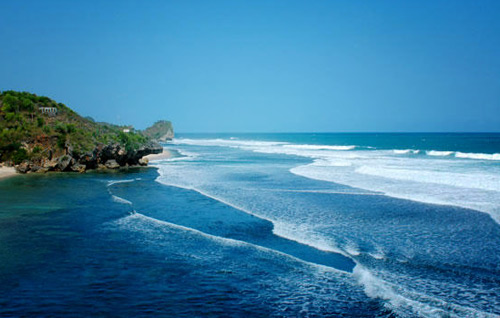 Sepanjang Beach is one of newly opened beaches. The name
Sepanjang which means long derives from the characteristic of the beach
that has the longest coastal lines of all beaches in Gunung Kidul. The
atmosphere of this beach is so natural. The seaside is decorated with
palm trees and huts roofed with dry leaves. The coral reef in the rise
and fall of tides area is kept well. The dashes of waves reflect blue
color signaling uncontaminated seawater. With such a situation, it is
not false if the local government and investors plan to make this beach
as the second Kuta Beach. Sepanjang has long coastal lines, clean water
sands, and medium waves. We can just choose: suns bathing under the
bright sun, surfing, or just enjoy the beach beauty. We can enjoy all
the things when we come to the beach that lies some kilometers from
Sundak Beach.
Sepanjang Beach is one of newly opened beaches. The name
Sepanjang which means long derives from the characteristic of the beach
that has the longest coastal lines of all beaches in Gunung Kidul. The
atmosphere of this beach is so natural. The seaside is decorated with
palm trees and huts roofed with dry leaves. The coral reef in the rise
and fall of tides area is kept well. The dashes of waves reflect blue
color signaling uncontaminated seawater. With such a situation, it is
not false if the local government and investors plan to make this beach
as the second Kuta Beach. Sepanjang has long coastal lines, clean water
sands, and medium waves. We can just choose: suns bathing under the
bright sun, surfing, or just enjoy the beach beauty. We can enjoy all
the things when we come to the beach that lies some kilometers from
Sundak Beach.Gebang Temple
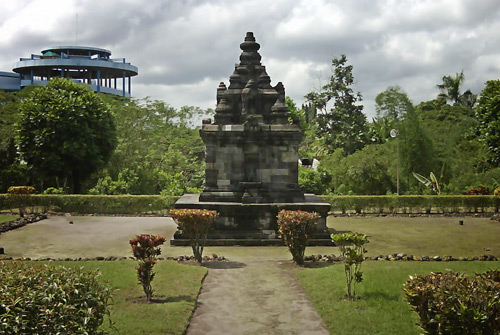 Gebang Temple is located on Condongcatur Region, south of Gebang
Village, Ngemplak, Sleman. It is about 11 Kilometer from Yogyakarta
town center. Gebang Temple (Gebang Temple) was established in early
Central Java Age (about years 730 - 800). It's background of
establishing, however, has remained a mystery. Gebang Temple,
Jogyakarta, a blend of Buddha-Hindu temple. A Ganesha enchased on its
architecture. This Temple has several peculiar features that can't find
on other Hindu's temples; such as peak of the Temple is formed "lingga"
stand over "Seroja" flower. The Ganesha Statue inside the chamber sat
over "Yoni", and inside the main chamber that usually placed by worship
God, here content a "lingga". Another peculiar feature is there is no
stair connected to main chamber, so this main chamber difficult to
reach.
Gebang Temple is located on Condongcatur Region, south of Gebang
Village, Ngemplak, Sleman. It is about 11 Kilometer from Yogyakarta
town center. Gebang Temple (Gebang Temple) was established in early
Central Java Age (about years 730 - 800). It's background of
establishing, however, has remained a mystery. Gebang Temple,
Jogyakarta, a blend of Buddha-Hindu temple. A Ganesha enchased on its
architecture. This Temple has several peculiar features that can't find
on other Hindu's temples; such as peak of the Temple is formed "lingga"
stand over "Seroja" flower. The Ganesha Statue inside the chamber sat
over "Yoni", and inside the main chamber that usually placed by worship
God, here content a "lingga". Another peculiar feature is there is no
stair connected to main chamber, so this main chamber difficult to
reach.Mendut Temple
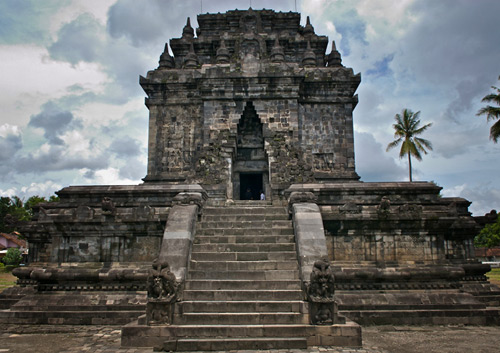 Mendut Temple is the older temple than Borobudur Temple. There
are stories for children on its walls. It is located 1 km to the east of
Pawon temple. There are magnificent statues of Buddha inside the
temples. For Waisak ceremony, the offering and the praying start in this
temple.
Mendut Temple is the older temple than Borobudur Temple. There
are stories for children on its walls. It is located 1 km to the east of
Pawon temple. There are magnificent statues of Buddha inside the
temples. For Waisak ceremony, the offering and the praying start in this
temple.Mendut Temple is frequently used to celebrate the Waisak day every May full moon and the pilgrims from Indonesia and all parts of the world come to this ceremony. Its architecture is square, and have an entrance on its steps. Its roof is also square and terraced. There are stupas (= bell-shaped structures) on it.
Pawon Temple
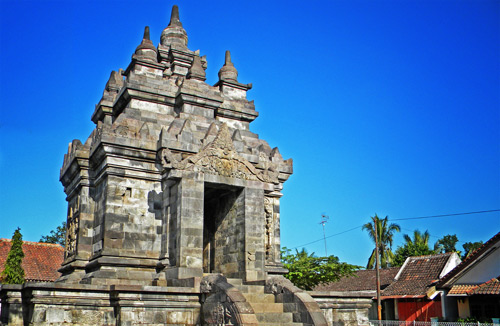 Pawon Temple is not a grave but as a place to keep King Indra's
weapon namely Vajranala. Tiny temple 2 km east of Borobudur, contains a
Buddha statue. The temple's style and the relief carved on the wall
resemble most Javanese Hindu Temple. Pawon Temple is one and half
kilometers westward from Mendut Temple and eastward from Borobudur
Temple; it is also a Buddhist temple. When appreciating in detail, its
sculpture is the beginning of Borobudur sculpture.
Pawon Temple is not a grave but as a place to keep King Indra's
weapon namely Vajranala. Tiny temple 2 km east of Borobudur, contains a
Buddha statue. The temple's style and the relief carved on the wall
resemble most Javanese Hindu Temple. Pawon Temple is one and half
kilometers westward from Mendut Temple and eastward from Borobudur
Temple; it is also a Buddhist temple. When appreciating in detail, its
sculpture is the beginning of Borobudur sculpture.This temple was built with volcanic stones. Architecturally it is a blend of old Javanese Hindu and Indian art. Pawon temple is exactly in the central point of the straight line stretched from Borobudur to Mendut Temple. Perhaps it was built for kubera. It is on a wide rather terrace with steps. All parts are decorated with stupa(s) on dagoba(s) and its outside walls with symbolic pictures.
Prambanan Temple
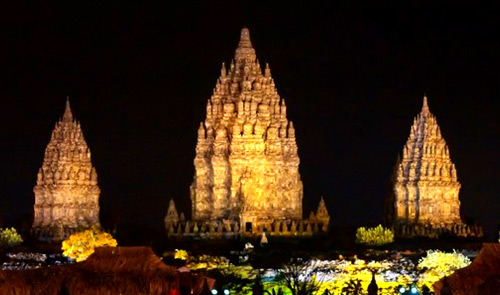 This is the most famous and also the most magnificent of Central
Java's temples or more precisely complex of temples. Situated about 15
kilometers from Yogyakarta, the top of the main shrine is visible from a
great distance and rises high above the scattered ruins of the former
temples. Prambanan is the masterpiece of Hindu culture of the tenth
century. The slim building soaring up to 47 meters makes its beautiful
architecture incomparable. Seventeen kilometers east of Yogyakarta, King
Balitung Maha Sambu built the Prambanan temple in the middle of the
ninth century. Its parapets are adorned with bas-reliefs depicting the
famous Ramayana story. This magnificent Shivaite temple derives it name
from the village where it is located.
This is the most famous and also the most magnificent of Central
Java's temples or more precisely complex of temples. Situated about 15
kilometers from Yogyakarta, the top of the main shrine is visible from a
great distance and rises high above the scattered ruins of the former
temples. Prambanan is the masterpiece of Hindu culture of the tenth
century. The slim building soaring up to 47 meters makes its beautiful
architecture incomparable. Seventeen kilometers east of Yogyakarta, King
Balitung Maha Sambu built the Prambanan temple in the middle of the
ninth century. Its parapets are adorned with bas-reliefs depicting the
famous Ramayana story. This magnificent Shivaite temple derives it name
from the village where it is located.Prambanan Temple is locally known as the Roro Jonggrang Temple, or the Temple of the "Slender Virgin", it is the biggest and most beautiful Hindu temple in Indonesia. The temple complex of Prambanan lies among green fields and villages. It has eight shrines, of which the three main ones are dedicated to Shiva, Vishnu and Brahma. The main temple of Shiva rises to a height of 130 feet and houses the magnificent statue of Shiva's consort, Durga. There are 224 temples in the complex; three of them, the main temples are Brahma Temple in the north, Vishnu Temple in the south, and the biggest among the three which lies between Brahma and Vishnu temples is Shiva Temple (47 meters high).
Two theatres have provided the temple. Enjoy sunrise behind the glory of Prambanan Temple. Visitors should be at the location - in the area of The Open Air Theater and archaeological park of the temple - before sunrise at about 5:00 o'clock in the morning. The First open-air theatre was built on the southern side of the temple in 1960 and the second was built on the western side of the temple in 1988. During full moon evenings in the month from May to October, the Ramayana ballet is performed right here. Perhaps one of the most majestic temples in the South-East Asia, Prambanan attracts many admirers each year from abroad.
Kalasan Temple
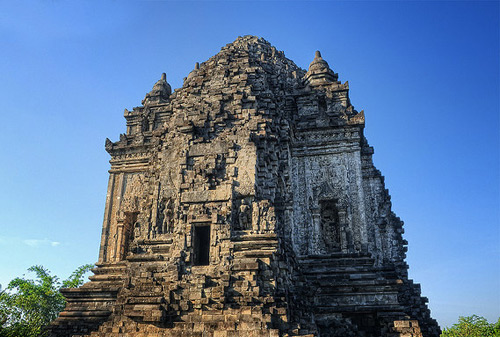 Kalasan Temple is built in Kalasan village about 2 km west of
Prambanan, 15 km from Yogyakarta. _It is dedicated to a Buddhist
Goddess, TARA. It is 6 meters tall and has 52 stupas. This unique
Buddhist temple is located east of Yogyakarta, on the south side of the
main road between Yogyakarta and Solo. It was built in honor of the
marriage between king Pancapana of Sanjaya Dynasty and a Princess of
Syailendra Dynasty, named Dyah Pramudya Wardhani. It is beautifully
ornamented with finely carved relief and coated with "vajralepa", a
yellowish material made from the sap of a certain tree. The vajralepa
functioned as an adhesive and as protection against moss and mildew,
while at the same time it refined the carvings. This temple is 24 m high
and its base built in the form of a Greek cross.
Kalasan Temple is built in Kalasan village about 2 km west of
Prambanan, 15 km from Yogyakarta. _It is dedicated to a Buddhist
Goddess, TARA. It is 6 meters tall and has 52 stupas. This unique
Buddhist temple is located east of Yogyakarta, on the south side of the
main road between Yogyakarta and Solo. It was built in honor of the
marriage between king Pancapana of Sanjaya Dynasty and a Princess of
Syailendra Dynasty, named Dyah Pramudya Wardhani. It is beautifully
ornamented with finely carved relief and coated with "vajralepa", a
yellowish material made from the sap of a certain tree. The vajralepa
functioned as an adhesive and as protection against moss and mildew,
while at the same time it refined the carvings. This temple is 24 m high
and its base built in the form of a Greek cross.Sewu Temple
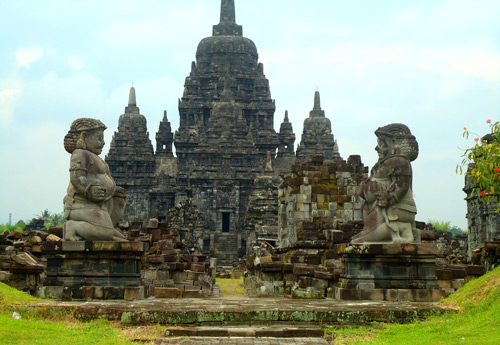 Sewu Temple is located 2 km north of Prambanan Temple. This is
the second largest Buddhist Temple complex in Java; Restoration is
professionally underway to reach its original form. It is a MANDALA,
manifesting the universe in the center temple of Mahadeva, surrounded by
four rings of 250 smaller temples of Gods. Sewu Temple complex is
located in Prambanan Temple Park area, about 800 meters to the north of
Rara Jongrang Temples. The fact that this temple was built near
Prambanan Temple, which is a Hindu temple, indicated that the Hindus and
Buddhists lived in harmony.
Sewu Temple is located 2 km north of Prambanan Temple. This is
the second largest Buddhist Temple complex in Java; Restoration is
professionally underway to reach its original form. It is a MANDALA,
manifesting the universe in the center temple of Mahadeva, surrounded by
four rings of 250 smaller temples of Gods. Sewu Temple complex is
located in Prambanan Temple Park area, about 800 meters to the north of
Rara Jongrang Temples. The fact that this temple was built near
Prambanan Temple, which is a Hindu temple, indicated that the Hindus and
Buddhists lived in harmony.The main temple has 1 main room and 4 small rooms of which are doorways to the temple. The east door serves as main door to the main room. That way, the main temple faces to the east. The structure has 9 'roofs'; each of them forms a stupa on the top. It is believed to be a royal temple and was one of the religious activity centers in the past. Based on the inscription dated back to 792 AD, which was found in 1960, the name of the temple complex was probably "Manjus'rigrha" (The House of Manjusri). Manjusri is one of Boddhisatva in Buddhist teaching. Sewu Temple was probably built in the 8th century at the end of Rakai Panangkaran administration. Rakai Panangkaran (746 AD - 784 AD) was a popular king from the old Mataram kingdom. HC Cornelius studied the temple firstly in 1807. NJ Krom did the first archeological study in 1923.
Kota Gede
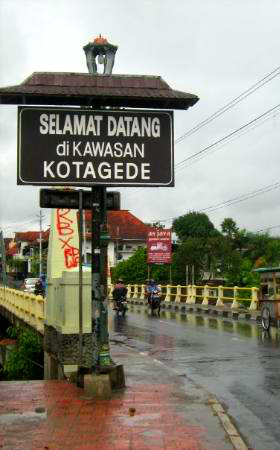 Kota Gede, which is often called Sargede is located about five
kilometers southeast of Yogyakarta, Kotagede is a neat little town,
which was once the seat of the mighty Mataram Empire. Since the 1930s,
Kotagede has become famous for being the center of the Yogya silverwork
industry. There are a number of workshops where visitors are welcome to
watch silver being transformed into beautiful works of art known as
"Yogya Silver". Kotagede is easily reached by "andong", the four-wheeled
horse-drawn cart, by taxi, bus, or car.
Kota Gede, which is often called Sargede is located about five
kilometers southeast of Yogyakarta, Kotagede is a neat little town,
which was once the seat of the mighty Mataram Empire. Since the 1930s,
Kotagede has become famous for being the center of the Yogya silverwork
industry. There are a number of workshops where visitors are welcome to
watch silver being transformed into beautiful works of art known as
"Yogya Silver". Kotagede is easily reached by "andong", the four-wheeled
horse-drawn cart, by taxi, bus, or car.In that cemetery complex one can still visit the cemetery of the Mataram kings like Sutowijoyo or Ngabei Loring Pasar, the founder of Mataram Kingdom, who was then called Panembahan Senopati. There is also the unique tomb of Ki Ageng Mangir. He was Panembahan Senopati son in law and also Panembahan Senopati enemy. His dead body was buried half inside of the special area for kings and Panembahan Senopati families, and a half of his body was buried outside of the complex. There is a stone called " Watu Gilang ", a stone on which Panembahan Senopati smashed the Ki Ageng Mangir head to dead.
Those who want to go inside the cemetery have to wear traditional clothes that one can hire at the place. Kota Gede Royal cemetery is open on Monday at. 10.00 am - 12.00 am, and Friday at 01.30 pm. - 04.00 pm. In addition to the cemetery, there are also graceful gates, a pond full of Clarius Melanodermas and a yellow turtle. This turtle is hundred years of age and people believe it as a sacred miraculous turtle.
Since the 1930s, however, Kotagede has become famous for being the centre of the Yogya silverwork industry. Kotagede is easily reached by "among", the four wheeled horse drawn cart, by taxi, bus, or car. There are a number of workshops where visitors are welcome to watch silver being transformed into beautiful works of art known as "Yogya Silver"
Kaliurang
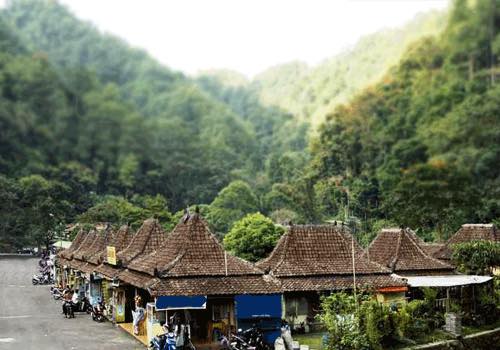 This resort is located on the slopes of Mt. Merapi, 24 km north
of Yogyakarta and surrounded by an enchanting countryside. "Telogo
Muncar" waterfall and swimming pool make this resort a very pleasant
recreation place. Kaliurang lies at the foot of Plawangan hill on the
southern slope of mount Merapi, some 28 km, north of Yogyakarta. This is
a refreshing holiday resort for those seeking refuge and tranquility
amidst the lush green tropical splendor.
This resort is located on the slopes of Mt. Merapi, 24 km north
of Yogyakarta and surrounded by an enchanting countryside. "Telogo
Muncar" waterfall and swimming pool make this resort a very pleasant
recreation place. Kaliurang lies at the foot of Plawangan hill on the
southern slope of mount Merapi, some 28 km, north of Yogyakarta. This is
a refreshing holiday resort for those seeking refuge and tranquility
amidst the lush green tropical splendor.Many people visit Kaliurang, especially during the holidays. Young people, like boy scouts, enjoy going there since the town provides camping sites and places for mountaineering. Those who like mountain climbing can climb Merapi Mountain from Kaliurang. One can stay overnight in Kaliurang then start, in the early morning, climbs Merapi via Kinahrejo village to descend again at noon.
When the weather is clear, a spectacular sight of the panoramic view that covers the surrounding forest of Plawangan and Kaliurang, and the rolling green countryside that fades into the distant misty horizon of the blue Indian Ocean can be seen easily. The best time to view the mountain is shortly after sunrise (before 09.00 o'clock), when the early morning light starts lifting up the shroud of mist around its peak.
Merapi Volcano
 Merapi volcano is one of the world's most active and dangerous
volcanoes. It contains an active lava dome, which regularly produces
pyroclastic flows. It has been active for 10,000 years. This fire
mountain remains one of the most active and dangerous volcanoes in the
world. It can be seen from its name; Merapi from Javanese word 'Meru'
means 'Mountain' and 'Api' means 'fire'. The internally giant smoking
Mount Merapi is one of the active volcanoes that found in Indonesia. It
is presenting its peaceful and sleepy dense forest.
Merapi volcano is one of the world's most active and dangerous
volcanoes. It contains an active lava dome, which regularly produces
pyroclastic flows. It has been active for 10,000 years. This fire
mountain remains one of the most active and dangerous volcanoes in the
world. It can be seen from its name; Merapi from Javanese word 'Meru'
means 'Mountain' and 'Api' means 'fire'. The internally giant smoking
Mount Merapi is one of the active volcanoes that found in Indonesia. It
is presenting its peaceful and sleepy dense forest.Beyond this, there lies a vast deserted land with its deep and steep valley spread out among the mountain hills where sibilant pines and wild grass make out the dominating vegetation, all presents a very exciting panorama. Merapi is located about 30 km north of Yogyakarta, a city with a population of 500,000. It is tall (2.8 km or 1.7 miles high) and has steep slopes. The top of the volcano sometimes has a normal crater, but usually a broad mound of pasty lava (called a dome) fills the crater. The dome plugs up the volcano, making it difficult for other lava and ash to escape. A broad gouge funnels lava and ash flows from the top of Merapi to the south slopes of the volcano.
During its resting time of volcanic activities, it will enable those who have much interest in mountaineering to have fun and to make them more acquainted with the flora of its tropical rain forest. From the observation post located on Plawangan hill that can be reached through the forest resort of Kaliurang, we will see the incredible sights of molten rocks oozing over the rim, sometimes accompanied with hot lava pouring out regularly and leaving a long trail of smoke.
Imogiri
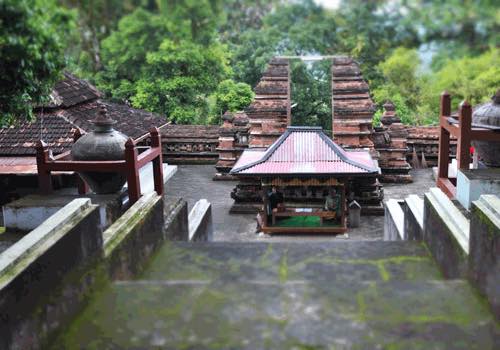 Imogiri is the official cemetery of the royal descendents from
Yogyakarta and Surakarta. This cemetery located on a beautiful hill
about 12 km from Yogyakarta. The royal graveyard is reachable by 345
stone steps leading to it. Imogiri is about 17 km Southeast of
Yogyakarta and easily accessible by the bus of car. The tombs are built
within three main courtyards. This Graveyard is the tomb of Sultan Agung
Hanyokrokusumo, the third king of the Islamic Mataram Kingdom. All the
kings of the Mataram Kingdom, from Sultan Hamengku Buwono I until
Hamengku Buwono IX and their families as the Surakarta Kingdoms as well
were all buried at the Imogiri Royal Cemetery.
Imogiri is the official cemetery of the royal descendents from
Yogyakarta and Surakarta. This cemetery located on a beautiful hill
about 12 km from Yogyakarta. The royal graveyard is reachable by 345
stone steps leading to it. Imogiri is about 17 km Southeast of
Yogyakarta and easily accessible by the bus of car. The tombs are built
within three main courtyards. This Graveyard is the tomb of Sultan Agung
Hanyokrokusumo, the third king of the Islamic Mataram Kingdom. All the
kings of the Mataram Kingdom, from Sultan Hamengku Buwono I until
Hamengku Buwono IX and their families as the Surakarta Kingdoms as well
were all buried at the Imogiri Royal Cemetery.This cemetery was built in 1645. Everyday many people visit Imogiri and step up on 345 stairs to reach the top of the hill where the tomb of the kings rested. Entry into the smaller courtyards housing the tombs of the princes is allowed, but the tomb can only be visited only on Monday 09.00 - 12.00 and Friday 13.00 - 16.00. The visitors must wear the traditional Javanese dress, which however can be hired on the spot at a modest fee. The cemetery is closed during the Moslem month of Ramadhan.
The Palace / Keraton Yogyakarta
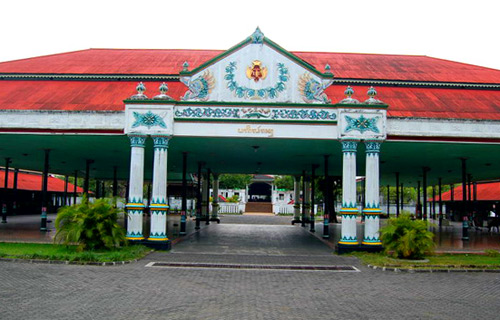 The palace court with its grand and elegant Javanese
architecture lies in the center of the city. Prince Mangkubumi founded
the palace in 1755. The Prince then was called Sri Sultan Hamengkubuwono
I and he chose the right location of the compound between Winongo River
and Code River. The palace stretches out from north to south. The front
yard is called alun-alun Utara (the North Square), and the back yard is
called Alun-alun Selatan (the South Square). The layout of the
buildings shows that the Palace, the commemorative column and Mount
Merapi lie in one line. The palace meeting hall is called Pagelaran,
where formal meetings of palace officials are held, while the "Manguntur
Tingkil" hall is the place where the Sultan is seated.
The palace court with its grand and elegant Javanese
architecture lies in the center of the city. Prince Mangkubumi founded
the palace in 1755. The Prince then was called Sri Sultan Hamengkubuwono
I and he chose the right location of the compound between Winongo River
and Code River. The palace stretches out from north to south. The front
yard is called alun-alun Utara (the North Square), and the back yard is
called Alun-alun Selatan (the South Square). The layout of the
buildings shows that the Palace, the commemorative column and Mount
Merapi lie in one line. The palace meeting hall is called Pagelaran,
where formal meetings of palace officials are held, while the "Manguntur
Tingkil" hall is the place where the Sultan is seated.The visitors can enjoy the atmosphere of the kraton in former times by visiting the life-size diorama of wedding ceremonies on the palace meeting hall, performed by puppets, which are intentionally arranged to create such an atmosphere. Sets of Javanese musical instruments, antiques and heirlooms have made the palace of Yogyakarta worth to visit. Many sets of gamelan music instruments, antiques, and heirlooms make the palace of Yogyakarta the most interesting tourist attractions in Yogyakarta. The palace of Ngayogyokarto Hadiningrat is now the dwelling place of Sultan Hamengku Buwono X and the family.
West of the palace, there is Water Castle, built in 1758 by the prince, Sultan Hamengkubuwono I. The Water Castle is located in the older part of the city within walking distance from the Bird Market. Part of the pleasure garden and castle is at present no more than an intriguing collection of ruins, pools, arches and underground passages enclosed by massive walls, however, the central courtyard with the nymph-baths has been restored. A number of batik workshops line the avenue leading to the pleasure garden's entrance.
JAKARTA TOURISM OBJECTS
National Monument
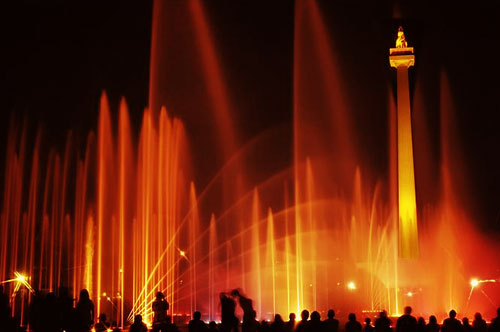 The National Monument, or "Monas" as it is popularly called, is
one of the monuments built during the Sukarno era of fierce nationalism.
The top of the National Monument (Monas) is Freedom Square. It stands
for the people's determination to achieve freedom and the crowning of
their efforts in the Proclamation of Independence in August 1945. The
137-meter tall marble obelisk is topped with a flame coated with 35 kg
of gold. The base houses a historical museum and a hall for meditations.
The monument is open to the public and upon request the lift can carry
visitors to the top, which offers a bird's eye view on the city and the
sea.
The National Monument, or "Monas" as it is popularly called, is
one of the monuments built during the Sukarno era of fierce nationalism.
The top of the National Monument (Monas) is Freedom Square. It stands
for the people's determination to achieve freedom and the crowning of
their efforts in the Proclamation of Independence in August 1945. The
137-meter tall marble obelisk is topped with a flame coated with 35 kg
of gold. The base houses a historical museum and a hall for meditations.
The monument is open to the public and upon request the lift can carry
visitors to the top, which offers a bird's eye view on the city and the
sea.Go early to beat the crowds and the haze. It is easy for the less physically able as lifts take visitors to the top. The diorama exhibition in the basement gives such a distorted view of Indonesian history - thanks to the dictator Suharto wanting to brainwash the nation - it's amusing. This imposing obelisk is Jakarta's most famous landmark. Construction started in 1961 under President Soekarno but was not completed until 1975, under President Soeharto. The monument houses a couple of museums. The Freedom Hall depicts Indonesia's struggle for independence through a series of dioramas, whereas the Hall of Contemplation displays the original Declaration of Independence document and a recording of the speech. An elevator takes one to the observation platform, which commands a bird's-eye view of the cityscape.
Beautiful Indonesia in Miniature Park (TMII)
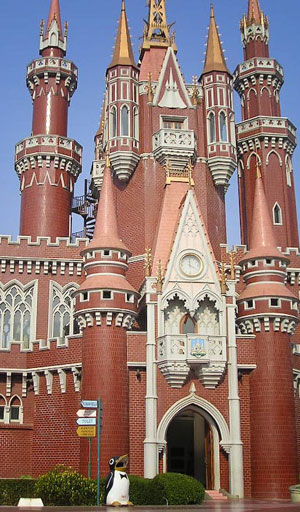 Taman Mini Indonesia Indah (Beautiful Indonesia in Miniature
Park) is Indonesia's answer to every visitor's prayer to see the
magnificent archipelago in just one day. An extensive park to get a
glimpse of the diverseness of the Indonesian archipelago, it represents
Indonesia's 27 provinces and their outstanding characteristics,
reflected most strikingly in the exact regional architecture of the
province. An extensive theme park set in over 100 hectares on the
outskirts of Jakarta; the All Indonesian islands are realistically
reproduced in miniature in a central lake and around the lakes, there
are pavilions. Each pavilions is representative of each province firm
the traditional architectural style in miniature to a wonderful display
of cultural items and exhibits. The park's centerpiece is a beautiful
artificial lake. The complex was the brainchild of Madam Tien Soeharto,
the late Indonesian first lady.
Taman Mini Indonesia Indah (Beautiful Indonesia in Miniature
Park) is Indonesia's answer to every visitor's prayer to see the
magnificent archipelago in just one day. An extensive park to get a
glimpse of the diverseness of the Indonesian archipelago, it represents
Indonesia's 27 provinces and their outstanding characteristics,
reflected most strikingly in the exact regional architecture of the
province. An extensive theme park set in over 100 hectares on the
outskirts of Jakarta; the All Indonesian islands are realistically
reproduced in miniature in a central lake and around the lakes, there
are pavilions. Each pavilions is representative of each province firm
the traditional architectural style in miniature to a wonderful display
of cultural items and exhibits. The park's centerpiece is a beautiful
artificial lake. The complex was the brainchild of Madam Tien Soeharto,
the late Indonesian first lady.It also has its own orchid garden in which hundreds of Indonesian orchid varieties are grown. There is also a bird park with a walk-in aviary, a fauna museum and recreational grounds with a swimming pool and restaurants. The special interest here at Taman Mini is the Museum Indonesia. A richly decorated building in Balinese architecture, it houses contemporary arts, crafts and traditional costumes from the different regions of the country.
Cultural performances, events, and even local delicacies from the provinces are prepared regularly, especially during weekends and holidays, to showcase Indonesia's rich cultural heritage. The park is open seven days a week, giving guests ample time to explore and enjoy the sights. And if a day tour is not enough, visitors can spend the night at the 'Desa Wisata' or 'Wisata Remaja' serviced accommodations.
"Theater Imax Keong Emas" (Golden Snail Theater)
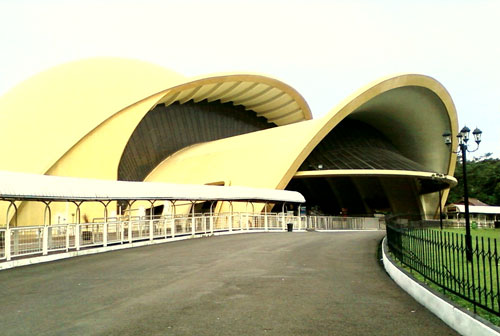 Keong Emas means Golden Snail. This theater is easily recognized
because the roof takes the shape a golden snail. Located in the Taman
Mini, the Imax Theater presents "Beautiful Indonesia" on a gigantic
screen using the latest Imax system. The theater was first open to the
public on April 20, 1984 and it's enormous screen, using the latest Imax
System, has been listed in the Guinness Book of Records as the largest
screen in the world during the 1985, 1986, 1987, 1988, 1989, 1990 and
1991 edition. This theater is located in East Jakarta, in the complex
area of Taman Mini Indonesia Indah (The Miniature of Indonesia Park),
which was also built on the initiative of Madame Tien Suharto.
Keong Emas means Golden Snail. This theater is easily recognized
because the roof takes the shape a golden snail. Located in the Taman
Mini, the Imax Theater presents "Beautiful Indonesia" on a gigantic
screen using the latest Imax system. The theater was first open to the
public on April 20, 1984 and it's enormous screen, using the latest Imax
System, has been listed in the Guinness Book of Records as the largest
screen in the world during the 1985, 1986, 1987, 1988, 1989, 1990 and
1991 edition. This theater is located in East Jakarta, in the complex
area of Taman Mini Indonesia Indah (The Miniature of Indonesia Park),
which was also built on the initiative of Madame Tien Suharto.The Keong Emas Imax Theater has become one of the most popular attractions where lots of tourists, domestic and foreign, young and adult, especially groups of children visit. Besides the large dimension of the screen, the theater also has another feature that makes it attractive: the films are displayed in three dimensions (3D). The subjects of the movies on display are mainly "Beautiful Indonesia" related to its culture and art, as well as its environment and the places around Indonesia. All in all, the main purpose of the movies is to highlight Indonesia's beauty on the big screen and attract tourism. This location is open from 11.00 am - 5.00 pm.
Jaya Ancol Dreamland (Taman Impian Jaya Ancol)
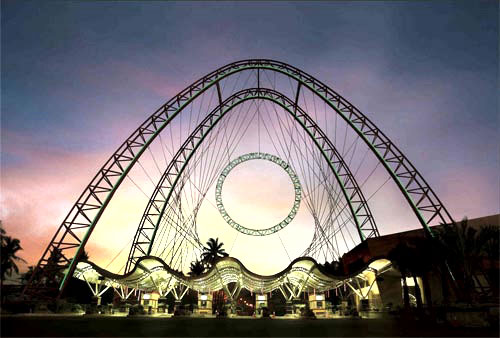 Taman Impian Jaya Ancol, an amusement park in north Jakarta,
Indonesia, is one of the most attractive places serving the densely
populated city of Jakarta. It has all the adventures people crave for;
Sea World, Fantasy World, Atlantis Water Adventure and Marina Beach.
This is Jakarta's largest and most popular recreation park. It is built
on reclaimed beach land at the Bay of Jakarta, having, sea and
freshwater aquariums, swimming pools, an artificial lagoon for fishing,
boating, bowling, an assortment of nightclubs, restaurants, a steam-bath
and massage parlors. The Ancol complex includes a Marina, Dunia Fantasi
(Fantasy Land), a golf course, hotels and a drive-in theater. The
"Pasar Seni" or art market has a varied collection of Indonesian
handicraft, paintings and souvenirs on sale. At a nearby open-air
theater art performances are held using the local dialect.
Taman Impian Jaya Ancol, an amusement park in north Jakarta,
Indonesia, is one of the most attractive places serving the densely
populated city of Jakarta. It has all the adventures people crave for;
Sea World, Fantasy World, Atlantis Water Adventure and Marina Beach.
This is Jakarta's largest and most popular recreation park. It is built
on reclaimed beach land at the Bay of Jakarta, having, sea and
freshwater aquariums, swimming pools, an artificial lagoon for fishing,
boating, bowling, an assortment of nightclubs, restaurants, a steam-bath
and massage parlors. The Ancol complex includes a Marina, Dunia Fantasi
(Fantasy Land), a golf course, hotels and a drive-in theater. The
"Pasar Seni" or art market has a varied collection of Indonesian
handicraft, paintings and souvenirs on sale. At a nearby open-air
theater art performances are held using the local dialect.Inside the Ancol Dreamland, there is Ancol Art Market, it is outdoor art market likely recreational place where we will be most tempted to purchase something. Items include antiques, handicrafts, painting, potters, and knickknacks. With many of the artisans working on site, it is a paradise for souvenir hunters and art lovers. This colorful open-air market located in the Ancol Amusement Park provides the unique experience of not only buying quality Indonesian arts and craft, but also a chance to see and meet the artisans at work. We can watch puppet makers, wood-carvers, painters, and many other craft makers from throughout the archipelago cheerfully working on their creations. At this art and handicraft market, visitors get to watch Indonesian artists creating their masterpieces. Hundreds of artists from all over the country congregate here to exhibit their work, making the spot a fascinating place for tourists and art connoisseurs. We can even get a portrait of our self-done. Both traditional and modern art and crafts are on display, including paintings, sculptures, traditional Indonesian wayang kulit (leather puppets), gemstone jewelry and many other artistic products. Art performances are frequently held at the Art Market (Pasar Seni) inside the Jaya Ancol Dreamland on Jakarta's beach. They normally range from wayang kulit shadow plays to folk dances and modern drama. This location is open Monday to Saturday, from 2 p.m. to 9 p.m.; Sunday, from 10 a.m. to 9 p.m.
Sea World
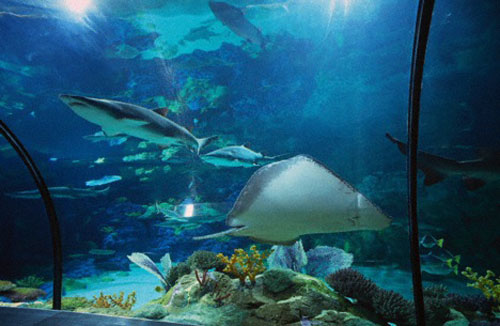 Inside the Ancol Dreamland complex, Sea World is a high tech
modern huge aquarium exhibiting the special and diverse tropical marine
life found throughout the Indonesian waters. Stroll through Freshwater
World and Micro world, see beautiful tropical fish and corral reefs, and
get friendly with marine life at the Touch pool. A theater screens
movies about the underwater world and a necessity is the Antasena
Tunnel, a walk-through acrylic tube that gives first hand experience of
life under the sea. This giant aquarium proudly introduces visitors to
more than 4,000 fish and sharks from 300 species. Sea World has great
many attractions to its credit; it has a Dolphin Show that is quite
popular and a gallery, which showcases many of sea creatures from all
over the world. Some times people find it better in comparison to
Sentosa Island, one of the most popular destinations in Singapore.
Inside the Ancol Dreamland complex, Sea World is a high tech
modern huge aquarium exhibiting the special and diverse tropical marine
life found throughout the Indonesian waters. Stroll through Freshwater
World and Micro world, see beautiful tropical fish and corral reefs, and
get friendly with marine life at the Touch pool. A theater screens
movies about the underwater world and a necessity is the Antasena
Tunnel, a walk-through acrylic tube that gives first hand experience of
life under the sea. This giant aquarium proudly introduces visitors to
more than 4,000 fish and sharks from 300 species. Sea World has great
many attractions to its credit; it has a Dolphin Show that is quite
popular and a gallery, which showcases many of sea creatures from all
over the world. Some times people find it better in comparison to
Sentosa Island, one of the most popular destinations in Singapore.Come and enjoy the deep-sea panorama while strolling through an 80-meter tunnel. The fascinating creatures live in some 500 million liters of seawater and are fed three times a day (some hand-fed). The attraction also features a theater, which plays three educational films in English and Bahasa Indonesia. Open Monday to Saturday, from 2 p.m. to 9 p.m.; Sunday, from 10 a.m. to 9 p.m.
Marina Jaya Ancol
 This is the port to reach Pulau Seribu (Thousand Islands) in the
Bay of Jakarta, as well as the center for marine sports ad recreation.
This is a special port for yachts, motor and sailboats, and the
scattered islands in the Bay of Jakarta. This is also the place for
marine recreation and sports where each facility is amply provided;
water cycles, canoes, sail boats, fishing gear and many others. Stalls
along the beach serve drinks and snacks while tents are available for
sunbathers and sea lovers.
This is the port to reach Pulau Seribu (Thousand Islands) in the
Bay of Jakarta, as well as the center for marine sports ad recreation.
This is a special port for yachts, motor and sailboats, and the
scattered islands in the Bay of Jakarta. This is also the place for
marine recreation and sports where each facility is amply provided;
water cycles, canoes, sail boats, fishing gear and many others. Stalls
along the beach serve drinks and snacks while tents are available for
sunbathers and sea lovers.Ancol Marina is the most usual departure point, speed boats leaving regularly to whisk us away from the city heat to the cool, palm fringed beaches of paradise. However chartering a boat is also possible for anyone with a more adventurous spirit. Jet skies canoes, sail boats wind surfing and waterskiing are all to be found, along with all kinds of fishing gear we may need for hire. Numerous stalls along the beach serve drinks and snacks while tents are available for sunbathers and sea-lovers.
Pelangi Island, a small island that located about 70 kilometers from Marina Ancol or about one and a half hours by speedboat, is a near Sepa Island and Pantara Island. The similarities of these beautiful islands are that they have sandy beaches and sit in the middle of a clean blue ocean. Pelangi Island had thronged by Italian and Japanese tourists. Presently, thanks to the domestic tourists and expatriates, the island economy is sustained.
T.I.M (Taman Ismail Marzuki) Art Center
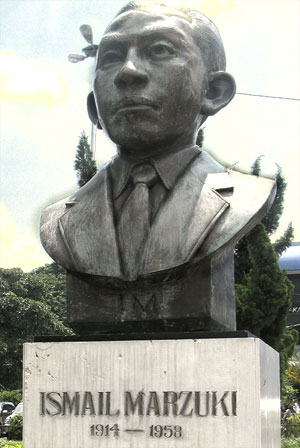 Jakarta is overflowing with hip clubs and bars catering to all
tastes. But if we want a snapshot of Jakarta's current artistic pulse
head to Taman Ismail Marzuki in Cikini. The center of Arts in Jakarta,
Taman Ismail Marzuki, also known as TIM, is a complex located on Cikini
Raya Street 37, Jakarta. Those who are looking for traditional and
contemporary arts might find this place useful. This complex acquired
its name from the great Indonesian musician, Ismail Marzuki, whose
statue guards the entrance gate. It hosts the Institut Kesenian Jakarta
(Jakarta Institute for the Arts) and Jakarta Platenarium. The arts
institute is the only one of its kind in Indonesia and the first local
college entirely dedicated to the training of performing and visual
arts. There are modern, state-of-the-art theatres and cinemas, more
traditional auditoriums, street performers and a cornucopia of
restaurants and bars offering basic but tasty food and drink from all
over Indonesia. The patrons range from the young, trendy,
keen-to-be-seen set to bohemian artistes debating the latest trends.
Jakarta is overflowing with hip clubs and bars catering to all
tastes. But if we want a snapshot of Jakarta's current artistic pulse
head to Taman Ismail Marzuki in Cikini. The center of Arts in Jakarta,
Taman Ismail Marzuki, also known as TIM, is a complex located on Cikini
Raya Street 37, Jakarta. Those who are looking for traditional and
contemporary arts might find this place useful. This complex acquired
its name from the great Indonesian musician, Ismail Marzuki, whose
statue guards the entrance gate. It hosts the Institut Kesenian Jakarta
(Jakarta Institute for the Arts) and Jakarta Platenarium. The arts
institute is the only one of its kind in Indonesia and the first local
college entirely dedicated to the training of performing and visual
arts. There are modern, state-of-the-art theatres and cinemas, more
traditional auditoriums, street performers and a cornucopia of
restaurants and bars offering basic but tasty food and drink from all
over Indonesia. The patrons range from the young, trendy,
keen-to-be-seen set to bohemian artistes debating the latest trends.The focal point of cultural activities in Jakarta is the Jakarta Art Center, known as Taman Ismail Marzuki or TIM in short. It is said to be the largest of its kind in Southeast Asia and consists of exhibition halls, theaters, an academy of arts, an archives building and a planetarium. A monthly programmed of events, available at hotel counters, includes exhibitions, plays, musical and poetry recitals, dance performances, folk art and drama from the various regions of Indonesia. Facilities include an indoor and outdoor theater, exhibition halls, two art galleries and a cineplex.
Pulau Seribu (Thousand Island)
 Thousand Isles near Jakarta has been a favorite destination for
ages. Paradiso, containing four island's Kahyangan (formerly known as
Cipir), Bidadari (used to be called Sakit), Onrust and Kelor offer
spectacular views of the forest and the sea. The name Paradiso indeed
comes from Paradise, for 'Kahyangan' in Indonesian means 'Heaven' in
English, and 'Bidadari' means 'Angel'. Dotted throughout Jakarta Bay are
120 tropical islands and coral atolls known, rather misleadingly, as
the Thousand Islands. This group of islands in the Jakarta Bay offers a
heaven away from the bustle of city life. There are golden beaches
fringed with coconut palms. The surrounding waters are a paradise for
skin divers. They are filled with a myriad of tropical fish, which live
among the multicolored corals. The islands can be reached from Tanjung
Priok or Pasar Ikan (Sunda Kelapa) by ferry or by chartered boat. Some
of the islands in this group developed for tourism are Pulau Bidadari,
Pulau Anyer, Pulau Laki and Pulau Putri. Pulau Tanjung near Putri has an
airstrip. There are cabins for hire, having fresh water on Pulau Air
and Pulau Bidadari only. The Pulau Putri Paradise Co. has developed
Pulau Putri, Pulau Melintang, Pulau Petondan and Pulau Papa Theo as a
holiday resort with cottages, restaurants, diving and sailing
facilities. With a total population of only 13,000 people, the bay
contains a sprinkling of the 'virgin islands', although the majorities
are inhabited. Many are privately owned. The departure point to this
cluster of individual paradises is the Ancol Marina, where further
information on travel arrangements can be found. Daliy boats to most
islands, departing at 08.00 and 09.00.
Thousand Isles near Jakarta has been a favorite destination for
ages. Paradiso, containing four island's Kahyangan (formerly known as
Cipir), Bidadari (used to be called Sakit), Onrust and Kelor offer
spectacular views of the forest and the sea. The name Paradiso indeed
comes from Paradise, for 'Kahyangan' in Indonesian means 'Heaven' in
English, and 'Bidadari' means 'Angel'. Dotted throughout Jakarta Bay are
120 tropical islands and coral atolls known, rather misleadingly, as
the Thousand Islands. This group of islands in the Jakarta Bay offers a
heaven away from the bustle of city life. There are golden beaches
fringed with coconut palms. The surrounding waters are a paradise for
skin divers. They are filled with a myriad of tropical fish, which live
among the multicolored corals. The islands can be reached from Tanjung
Priok or Pasar Ikan (Sunda Kelapa) by ferry or by chartered boat. Some
of the islands in this group developed for tourism are Pulau Bidadari,
Pulau Anyer, Pulau Laki and Pulau Putri. Pulau Tanjung near Putri has an
airstrip. There are cabins for hire, having fresh water on Pulau Air
and Pulau Bidadari only. The Pulau Putri Paradise Co. has developed
Pulau Putri, Pulau Melintang, Pulau Petondan and Pulau Papa Theo as a
holiday resort with cottages, restaurants, diving and sailing
facilities. With a total population of only 13,000 people, the bay
contains a sprinkling of the 'virgin islands', although the majorities
are inhabited. Many are privately owned. The departure point to this
cluster of individual paradises is the Ancol Marina, where further
information on travel arrangements can be found. Daliy boats to most
islands, departing at 08.00 and 09.00.This chain of several dozen islets immediately north of the city is administratively part of Jakarta and usually an oasis of quiet. Speedboats take visitors to basic but comfortable hotels an hour or so from the city, where one can snorkel, dive or just lie on a white sand beach with a friendly turtle.
Ragunan Zoo
 Ragunan zoo in South Jakarta is a popular place to visit,
particularly during holidays. Jakarta's zoo is situated in the suburb of
Ragunan in the southern part of the city. Laid out in a lush tropical
setting, such indigenous animals as the Komodo lizard, tapir, anoa, Java
tiger, banteng, wild ox and brightly colored birds are given ample room
to be in this green foliage. The new primates are centered at Ragunan
Zoo. It's a world-class facility and guaranteed to entertain and educate
both the young and young at heart.
Ragunan zoo in South Jakarta is a popular place to visit,
particularly during holidays. Jakarta's zoo is situated in the suburb of
Ragunan in the southern part of the city. Laid out in a lush tropical
setting, such indigenous animals as the Komodo lizard, tapir, anoa, Java
tiger, banteng, wild ox and brightly colored birds are given ample room
to be in this green foliage. The new primates are centered at Ragunan
Zoo. It's a world-class facility and guaranteed to entertain and educate
both the young and young at heart.According to its history, Taman Margasatwa Ragunan, or Ragunan Wildlife Reserve, was first set up by a Dutch flora and fauna lovers organization. The organization, the Vereneging Plantenen Dierentuin at Batavia, set up the park on a 10-hectare plot of land in Cikini Raya Street 2, South Jakarta in 1864. The park, Plantenen Dierentuin, was moved to the present location in 1964 to accommodate the city's development plan. In the new location, the park was given a 10-hectare plot of land, but now it occupies 135 hectares of land. This zoo was located at Cikini until 1964, when the site was no longer large enough to accommodate its rapid expansion. Reopened in 1966, the zoo now exhibits 550 species of tropical plants and animals from Indonesia and around the world. Endangered species bred here include the Sumatran tiger, Komodo dragon, dwarf buffalo and bird of paradise.
Now, the zoo is busy preparing a 10-hectare enclosure, which was described by the director as the largest and most luxurious one in the world, for the new guests. The spot is ideal for family excursions and picnics amid the abundant flora. Come during weekdays when it is less crowded. Open dally from 8.00 a.m. to 6.00 p.m. The zoological garden is most crowded on Sunday and public holidays.
National Museum
 The Museum is situated on Merdeka Barat Street. Currently the
National Museum houses collections of 109,342 objects under the
categories of prehistory, archaeology, ethnography,
numismatics-heraldic, geography and historical relics. In 1994, the
museum started with is expansion project. The new building, constructed
in the same architectural style as the old, comprises an arena for
theatrical performances and more spaces for exhibitions. The museum
curators provide detailed information and guidance on
collections-related subjects during working hours. The daily activities
at the National Museum include collecting, caring for and protecting
collections and providing information on the museum and its collections
to visitors and the public at large. The Indonesian Heritage Society
(HIS) voluntarily assists the museum in handling the inventory of the
collections.
The Museum is situated on Merdeka Barat Street. Currently the
National Museum houses collections of 109,342 objects under the
categories of prehistory, archaeology, ethnography,
numismatics-heraldic, geography and historical relics. In 1994, the
museum started with is expansion project. The new building, constructed
in the same architectural style as the old, comprises an arena for
theatrical performances and more spaces for exhibitions. The museum
curators provide detailed information and guidance on
collections-related subjects during working hours. The daily activities
at the National Museum include collecting, caring for and protecting
collections and providing information on the museum and its collections
to visitors and the public at large. The Indonesian Heritage Society
(HIS) voluntarily assists the museum in handling the inventory of the
collections.The museum's Conservation and Restoration Division is dedicated to conserving and restoring the collected objects in order to protect them from possible damages and loss. The staffs also take preventive measures against possible damages or loss through manual, alarm and control system. This Museum is open from 8.30 am to 2.30 pm on Tuesday, Wednesday, Thursday and Sunday, from 8.30 am to 11.30 am on Friday, and from 8.30 am to 1.30 pm on Saturday. The Museum is closed on Monday and Public Holidays.
This museum is also has supporting with such tourism facilities. A small gift shop located in the entrance hall has the same opening hours as the rest of The Museum. It offers a selection of books, postcards and reproductions of various exhibits. The front courtyard can accommodate cars and tour buses. Visitors are kindly asked to refrain from smoking, eating and drinking in all areas of the Museum, and are prohibited from touching the exhibits.
Jakarta History Museum
 Located in the historic Old Jakarta Kota area, Taman Fatahillah
square offers three of the city's most interesting museums. Once the
heart of the colonial administration in the 18th century the square
underwent a major restoration in the 1970's. A fountain in the middle of
square once as the main water supply for the former colonial capital.
The Portuguese cannon on the north side of the square is reportedly an
impressive font of fertility. Jakarta History Museum is the one
displaying the history of the development of the City of Jakarta, both
the events and the community, from the prehistory until these present
days. This museum is located in a building of cultural property which in
the past known as Stadhuis, the City Hall of Batavia. As written on an
inscription of the Museum collection, the building was constructed in
1707 by the city government of Batavia during the period of VOC and
Governor General Abraham van Riebeeck inaugurated it in 1710. This
building is located in front of a park, which in the past was known as
Stadhuisplein, the City Hall Park, and now it is called Taman
Fatahillah.
Located in the historic Old Jakarta Kota area, Taman Fatahillah
square offers three of the city's most interesting museums. Once the
heart of the colonial administration in the 18th century the square
underwent a major restoration in the 1970's. A fountain in the middle of
square once as the main water supply for the former colonial capital.
The Portuguese cannon on the north side of the square is reportedly an
impressive font of fertility. Jakarta History Museum is the one
displaying the history of the development of the City of Jakarta, both
the events and the community, from the prehistory until these present
days. This museum is located in a building of cultural property which in
the past known as Stadhuis, the City Hall of Batavia. As written on an
inscription of the Museum collection, the building was constructed in
1707 by the city government of Batavia during the period of VOC and
Governor General Abraham van Riebeeck inaugurated it in 1710. This
building is located in front of a park, which in the past was known as
Stadhuisplein, the City Hall Park, and now it is called Taman
Fatahillah.Since 1970, the surroundings of Taman Fatahillah have been declared as Cultural Property and it was totally preserved. This effort was the beginning of the development of the historical area of the City of Jakarta, carried out by the Government of DKI Jakarta. The Museum of History of Jakarta was inaugurated on 30 March 1974 for being the center for collection, conservation and research for all kinds of objects of cultural property related to the history of the City of Jakarta and at the same time becomes a center for education, study and recreation for the community. Due the very long course of the history of Jakarta, the collection of this Museum are highly varied in shape and consist of objects being the heritage of the prehistorical period until the beginning of the 20th century. There are another replicas of the Tugu Inscription from the age of Great King Purnawarman, forming evidence that the center of the Kingdom of Tarumanegara was located in around the seaport of Tanjung Priok. Further, a map of the 16th century and the replica of the Padrao monument of the Portuguese represent the historical evidence of the age of Sunda Kelapa Harbor. The period of Jayakarta is the beginning of the establishment of the City bronze cannon and through various drawings and maps of the 17th century. Furniture collection of Betawi style from the 17th, 18th and 19th century is the richest collection and belongs to the most complete one in the world. This collection is very interesting since the association reflects of the community of Batavia City with various cultural elements from Europe, especially Dutch, China, India and Indonesia.
Shadow Puppets Museum
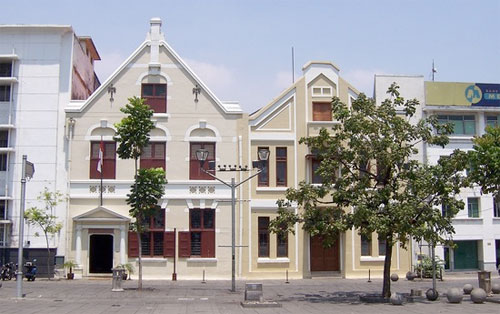 This artistic building stay at Pintu Besar Utara Street 27, West
Jakarta, was built in 1912, previously as land of a church, which was
built in 1640 under the name of De Oude Hollandsche Kerk (The Old Dutch
Church). In 1732 it was renovated and its name was changed into De
Nieuwe Hollandsche Kerk (The New Dutch Church). The church building was
once totally destroyed by an earthquake. Bataviasche Genootschap van
Kunsten en Wetenschappen (Batavia Society of Arts and Sciences), that
was an institution dealing with science and Indonesian culture bought
this building.
This artistic building stay at Pintu Besar Utara Street 27, West
Jakarta, was built in 1912, previously as land of a church, which was
built in 1640 under the name of De Oude Hollandsche Kerk (The Old Dutch
Church). In 1732 it was renovated and its name was changed into De
Nieuwe Hollandsche Kerk (The New Dutch Church). The church building was
once totally destroyed by an earthquake. Bataviasche Genootschap van
Kunsten en Wetenschappen (Batavia Society of Arts and Sciences), that
was an institution dealing with science and Indonesian culture bought
this building.The institution then delivered this building to the Stichting Oud Batavia (Old Batavia Foundation) and on 22 December 1939. It was made a museum under the name of Oude Bataviasche Museum (Old Batavia Museum). In 1957 this building was delivered to Lembaga Kebudayaan Indonesia (Institute of Indonesian Culture) and on 17 September 1962 it was delivered to the Ministry of Education and Culture of the Republic of Indonesia, which later was delivered to the DKI Jakarta Administration on 23 June 1968 to be made Shadow Puppet Museum, which inauguration was carried out on 13 August 1975.
Shadow Puppet (commonly known as wayang) in Indonesia, especially on Java Island, was originally a product of the Royal Court culture. It was first used as an instrument of worship to the ancestors, and after the Hindu culture entered Indonesia iaround the 5th century, it developed shifting of values. The world of Indonesian shadow puppet got characteristically influence especially in term of story, like the Ramayana (the Story of Rama) and Mahabharata (the Great Bharata), making the form of presentation keep on changing and with wider range in performance and in the theme of the story. In its later development the Indonesian shadow puppet had become such tradition, that it has been capable to hold out in the supporting community consisting of various elements. Visitors of this Museum are invited to know various characters, attitude and behavior of the story from various regions through the performance of shadow puppet that has weight of high value in our culture and viewing a number of collections of shadow puppet like wayang kulit, wayang golek, patung wayang, topeng wayang, wayang beber, wayang kaca, gamelan (traditional music instrument set) as well as wayang paintings.
This Museum also displays various collections of wayang and dolls from friendly countries like Malaysia, Thailand, Suriname, China, Vietnam, France, India and Cambodia. It is not merely to be an object for recreation, study for students/ devotee can be carried out in this Museum, and this Museum even can be used as venue for training, documentation center and research on shadow puppet, and it can be used as inter-regional and international media on cultural knowledge. To support its existence, in this Museum wayang staging and attraction of wayang making are periodically organized.
1945 Struggle for Freedom Museum
 1945 Struggle for Freedom Museum is located at Menteng Raya
Street 31, Central Jakarta. In 1938, a Dutch businessman named LC
Schomper, built a hotel called Schomper, I at Menteng Area. The hotel
was built as a place to spend nights for high officials of the
Nederland, foreign Entrepreneurs, and high officials of local
government.
1945 Struggle for Freedom Museum is located at Menteng Raya
Street 31, Central Jakarta. In 1938, a Dutch businessman named LC
Schomper, built a hotel called Schomper, I at Menteng Area. The hotel
was built as a place to spend nights for high officials of the
Nederland, foreign Entrepreneurs, and high officials of local
government.During the colonization of the Japanese Empire in Indonesia youth and it was turned into a boarding house and Education center for Indonesian Youth in order to learn nationalism. Soekarno (1st Indonesian President), Mohammad Hatta (1st Indonesian Vice President), Adam Malik Chaerul Saleh and many other youth generations of Indonesia are involved in the educations process inside. The name of the Hotel Schomper 1 Hotel then turned into Gedung Menteng 31 Building). As time went by, the Gedung Menteng 31 was used for many purposes. It was once used as office of Ministry of Manpower arrangement, National Boards of the Generation of 1945, and Jointly Secretariat of Nation Works Organization (secretariat Bersama Golongan Karya) - Embrio the GOLKAR Party.
After the building was renovated and repaired Gedung Menteng 31 was officially established as Museum Joang 45 on August 19, 1974, by former President Soeharto and former governor of Jakarta Ali Sadikin. The name, Museum Joang 45' is chosen as the building has played great role on the Independence if Indonesia and could become a site for the inheritance process of invaluable struggle values in 1945. The Museum is open from 8.00 am to 3.00 pm on Monday to Friday.
BANGKA BALITUNG TOURISM OBJECT
MATRAS BEACH
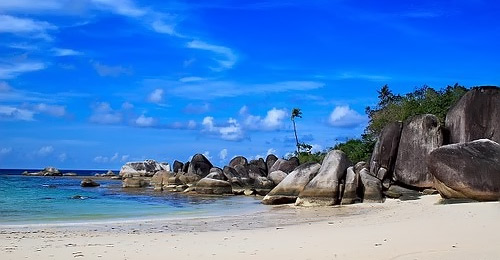 It is located in Sinar baru village, Sungailiat district in
eastern of Bangka Island. It about 9 Km from Sungailiat, it's considered
as the best in Bangka Island. The beach is about 3 kilometers long and
its width is almost 30 meters. It is unspoiled white sandy beach with
coconut trees around the beach area, the tropical breeze and sunshine.
Enjoy the warm and clear waters of the blue sea or just have a cooling
swim in the river entering the sea. This beach commonly called as the
Heaven Beach because it surrounded with coconut trees and visited by a
lot of visitor. An easily accessible beach can be found in the northeast
of Bangka, 48 km from Pangkal Pinang and 12 km from Sungai Liat.
It is located in Sinar baru village, Sungailiat district in
eastern of Bangka Island. It about 9 Km from Sungailiat, it's considered
as the best in Bangka Island. The beach is about 3 kilometers long and
its width is almost 30 meters. It is unspoiled white sandy beach with
coconut trees around the beach area, the tropical breeze and sunshine.
Enjoy the warm and clear waters of the blue sea or just have a cooling
swim in the river entering the sea. This beach commonly called as the
Heaven Beach because it surrounded with coconut trees and visited by a
lot of visitor. An easily accessible beach can be found in the northeast
of Bangka, 48 km from Pangkal Pinang and 12 km from Sungai Liat.PARAI TENGGIRI BEACH
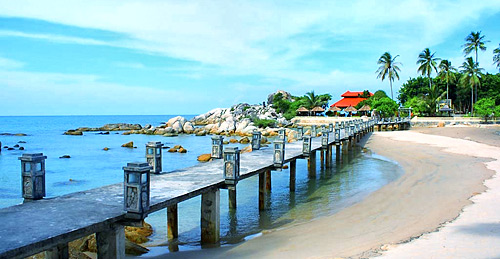 This beach is one of Bangka Island’s prides. The beach is
located in Sungailiat district. The visitors can find various forms of
boulders in this beach, which add its beauty. This beach is very ideal
for having swimming, sun bathing and relax. Parai Tenggiri beach has the
complete facilities in Bangka Island. There are luxurious hotels and
water sport facilities. The tourists will enjoy this beach with the
local fishermen who always spend their days by looking for fishes in the
sea. The calmness and fresh sea wind will greet the visitor when they
arrive there. This welcomed course make the tourists feel comfortable to
stay here.
This beach is one of Bangka Island’s prides. The beach is
located in Sungailiat district. The visitors can find various forms of
boulders in this beach, which add its beauty. This beach is very ideal
for having swimming, sun bathing and relax. Parai Tenggiri beach has the
complete facilities in Bangka Island. There are luxurious hotels and
water sport facilities. The tourists will enjoy this beach with the
local fishermen who always spend their days by looking for fishes in the
sea. The calmness and fresh sea wind will greet the visitor when they
arrive there. This welcomed course make the tourists feel comfortable to
stay here.ROMODONG BEACH
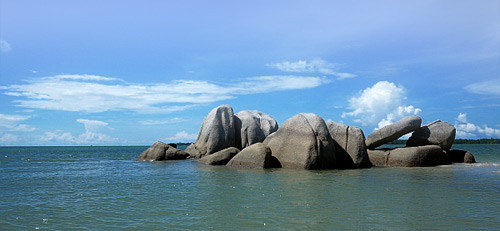 Romodong beach is located at Bukit Ketok village, Belinyu
district, Bangka regency. This beach is about 77 km of Sungailiat town.
In this beach, the tourists can watch the sunset, because this beach is
faced to west side. The length of this beach is about 4 km; it is slope,
white sandy and soft. Its water is very clear like a crystal. Enjoy the
beautiful of Romodong. When it low tide, you can walk in the water
until in the middle of clear sea. If we see around, we just find the
boulders and white sand that spread in the beach. The winds that make
the leaves wobbled greet the tourists who looking for an inspiration.
Romodong beach is located at Bukit Ketok village, Belinyu
district, Bangka regency. This beach is about 77 km of Sungailiat town.
In this beach, the tourists can watch the sunset, because this beach is
faced to west side. The length of this beach is about 4 km; it is slope,
white sandy and soft. Its water is very clear like a crystal. Enjoy the
beautiful of Romodong. When it low tide, you can walk in the water
until in the middle of clear sea. If we see around, we just find the
boulders and white sand that spread in the beach. The winds that make
the leaves wobbled greet the tourists who looking for an inspiration.MOUNT MENUMBUNG GUEST HOUSE
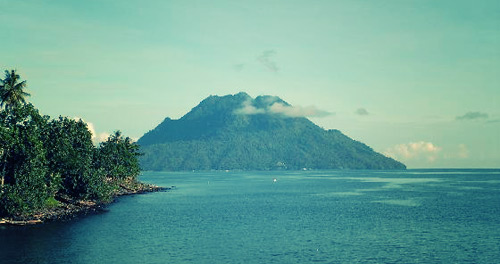 Mount Menumbung (355 meters) a rather high hill in the
neighborhood of Mentok (North West Banka) stands as a memorial to the
history of the Indonesian nation. It was built in 1932 during the DUTCH
occupation period by Bangka Tin Winning Bedrijf (BTW) as a V.I.P. Guest
House on the top of Mount Menumbung, is about 500 M above sea level.
Mount Menumbung (355 meters) a rather high hill in the
neighborhood of Mentok (North West Banka) stands as a memorial to the
history of the Indonesian nation. It was built in 1932 during the DUTCH
occupation period by Bangka Tin Winning Bedrijf (BTW) as a V.I.P. Guest
House on the top of Mount Menumbung, is about 500 M above sea level. Our former President Soekarno and the Vice President Moh. Hatta stayed in the guesthouse during their exile in 1949. Foreign missions came there for negotiating with our former President; the plane from UNCI (United Nations Commission for Indonesia) flew back and forth from Jakarta to Bangka Island during that period. This place is also called as Wisma Ranggam. The room, which was used, by the late President as well as his car is still can be seen in the building. Many Indonesians still like to visit this place of pilgrimage and see the well-kept personal belongings of the two former leaders, which are still in the compound.
TANJUNG KELIAN OLD LIGHTHOUSE
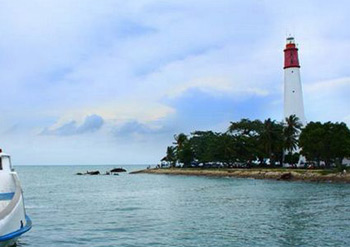 The old lighthouse was built in 1826. It is located about 9 km
of Muntok district. In the surrounding area we still can find wrecks of
Dutch and British ships, which were torpedoed by Japanese warships
during the Second World War, on 16 February 1942. Take our time to climb
up 199 steps to reach the top of the lighthouse and enjoy the
spectacular view from the height of approximately 60 M above sea level.
We can see the whole beaches in Muntok.
The old lighthouse was built in 1826. It is located about 9 km
of Muntok district. In the surrounding area we still can find wrecks of
Dutch and British ships, which were torpedoed by Japanese warships
during the Second World War, on 16 February 1942. Take our time to climb
up 199 steps to reach the top of the lighthouse and enjoy the
spectacular view from the height of approximately 60 M above sea level.
We can see the whole beaches in Muntok. TANJUNG PANDAN
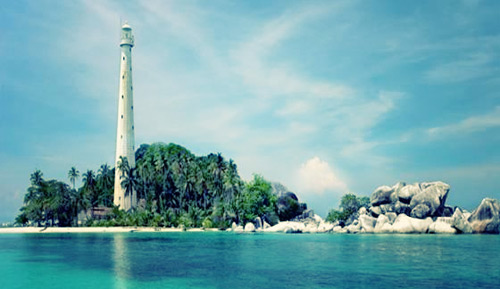 Like Bangka, Belitung is also called a tin island. It is the
second biggest tin producer in Indonesia. The capital town of Belitung
is Tanjung Pandan. It is about 45 minutes flights from Jakarta. The
topography consists of lowland and some small areas of swamp while in
the middle part there is highland in groups of 150 - 200 meters above
the sea level. Tanjung Pandan is stay at 1070 20’ East longitude and 020
30’ - 030 15 south latitudes. Its wide area is 229.365 Ha and bordered
by:
Like Bangka, Belitung is also called a tin island. It is the
second biggest tin producer in Indonesia. The capital town of Belitung
is Tanjung Pandan. It is about 45 minutes flights from Jakarta. The
topography consists of lowland and some small areas of swamp while in
the middle part there is highland in groups of 150 - 200 meters above
the sea level. Tanjung Pandan is stay at 1070 20’ East longitude and 020
30’ - 030 15 south latitudes. Its wide area is 229.365 Ha and bordered
by:North Side: South China Sea
East side: East Belitung Regency
South side: Jawa Sea
West side:Gaspar Strait
In Tanjung Pandan, there is a Geology museum, the omission of PT Timah, which save various historical and cultural collections. Beside that, Tanjung Pandan is also equipped with zoo and Dayanag Seri Pinai swimming pool. The famous beach in Tanjung Pandan is Tanjungpendam beach, which always held ‘Buang Jong’ ceremony every July and August.
TANJUNG TINGGI
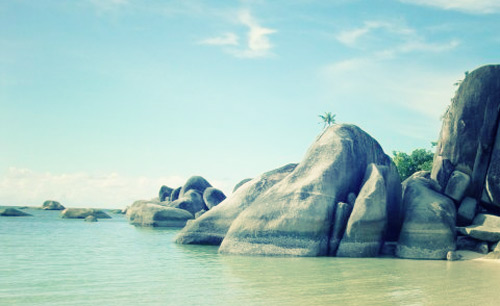 Belitung is beautiful. One of its beauties is Tanjung Tinggi
beach. This beach is located about 30 km of Tanjung Pandan, a beach that
has many types of granite and become the superior of Tanjung Tinggi.
The visitors can enjoy the beauty of this natural beach by stand on the
top of these granites or from the big stone. This natural beach is not
far from Tanjung Kelayang beach. It is really natural beach that
presents the nature scenery for the tourists who want to visit this
beach. Spoiled your self in this warmed of sun and the blue of sea. You
will feel that both of the beaches are your own.
Belitung is beautiful. One of its beauties is Tanjung Tinggi
beach. This beach is located about 30 km of Tanjung Pandan, a beach that
has many types of granite and become the superior of Tanjung Tinggi.
The visitors can enjoy the beauty of this natural beach by stand on the
top of these granites or from the big stone. This natural beach is not
far from Tanjung Kelayang beach. It is really natural beach that
presents the nature scenery for the tourists who want to visit this
beach. Spoiled your self in this warmed of sun and the blue of sea. You
will feel that both of the beaches are your own. The visitor can do some activities such as; swimming, sun bathing, surfing, fishing, etc. Beside that, this beach, which is rich of its granites with their various sizes, also has the natural carpet of white sand.
TANJUNG KELAYANG
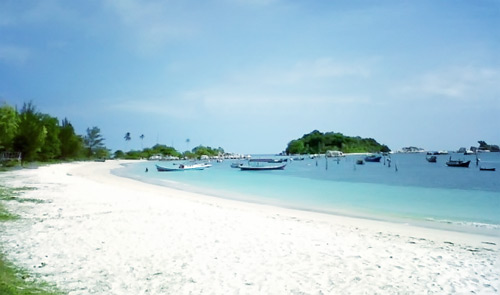 Tanjung Kelayang is one of Belitung’s beautiful beaches. This
beach is also offering white sandy beach with its unique stones that
strong stand up in various forms. The name of Tanjung Kelayang is taken
from its unique boulder that looks like a bird. The word ‘Tanjung’ means
‘Peninsula’ and ‘Kelayang’ means ‘a kind of bird species’. Tanjung
Kelayang is surround by small islands that framed the beautiful sunset.
Stay here to enjoy the moon that shines the seawater. The visitors can
spend their holiday here by diving, swimming, sun bathing, fishing, etc.
Tanjung Kelayang is one of Belitung’s beautiful beaches. This
beach is also offering white sandy beach with its unique stones that
strong stand up in various forms. The name of Tanjung Kelayang is taken
from its unique boulder that looks like a bird. The word ‘Tanjung’ means
‘Peninsula’ and ‘Kelayang’ means ‘a kind of bird species’. Tanjung
Kelayang is surround by small islands that framed the beautiful sunset.
Stay here to enjoy the moon that shines the seawater. The visitors can
spend their holiday here by diving, swimming, sun bathing, fishing, etc.
Walk along Tanjung Kelayang, the visitors will see the spread of boulders in the beach. These boulders that almost 5 meters size, are in piles each other uniquely. There is big stone that stick by three small stones. The positions of these small stones are unique. It is very attractive if the visitors walk along those boulders and jump on the top of the boulders. Those boulders are formed rooms and hole, the tourism object that make the visitor always want to take the picture in that boulders.
LENGKUAS ISLAND
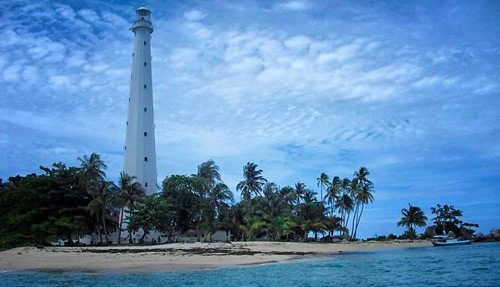 Belitung Island is surrounded by small islands, such as; Nasik
island, Lima island, Lengkuas island, Melindung island, Seliu island,
Nadu island, Mendanau island, Batu Dinding island and the other small
islands. One of them is Lengkuas Island. Lengkuas Island is a small
island, placed in North of Tanjung Binga village. This island is
surround by several granite rock islands that can reach by just walking
cross the seawater that less than 1,2m depth. Those granites are also
various unique forms. The water is totally clean, so we can easily see
the bottom of sea as well as fishes swimming inside the water. It is a
nice place for playing in the water or snorkeling.
Belitung Island is surrounded by small islands, such as; Nasik
island, Lima island, Lengkuas island, Melindung island, Seliu island,
Nadu island, Mendanau island, Batu Dinding island and the other small
islands. One of them is Lengkuas Island. Lengkuas Island is a small
island, placed in North of Tanjung Binga village. This island is
surround by several granite rock islands that can reach by just walking
cross the seawater that less than 1,2m depth. Those granites are also
various unique forms. The water is totally clean, so we can easily see
the bottom of sea as well as fishes swimming inside the water. It is a
nice place for playing in the water or snorkeling.This is a small island that unique, because it has a lighthouse and exciting scenery around it that can be enjoy from the top of the lighthouse. The Dutch builds this lighthouse in 19 century. The beach is totally crystal clear water, which has its white sandy. There are some granites island that can reach by swimming or walking through the water, which is less than 1,5 meter. The other islands that interest to visit is Burung Island, Babi Island, Pengadaran Island, Lutung Island, Kera Island dan Jenang Island.
TANJUNG BINGA
 Tanjung Binga village is in Sijuk district. If the visitors come
to the right season, they will find delicious Durian (kind of fruit).
In the side of Tanjung Binga village, you can find Bukit Berahu Cottages
that equipped with swimming pool a nine holes golf field. There are
about eight uninhabited small islands that become part of Tanjung Binga
village and it’s famous with its nature beautiful. This tourism object
is also famous with its beautiful beach, and fascinated granites. This
island is called Burung Island (Pulau Burung). It is about 12 hectares;
has coconut garden, and small hill. The visitors can visit those islands
by the fishermen’s canoe.
Tanjung Binga village is in Sijuk district. If the visitors come
to the right season, they will find delicious Durian (kind of fruit).
In the side of Tanjung Binga village, you can find Bukit Berahu Cottages
that equipped with swimming pool a nine holes golf field. There are
about eight uninhabited small islands that become part of Tanjung Binga
village and it’s famous with its nature beautiful. This tourism object
is also famous with its beautiful beach, and fascinated granites. This
island is called Burung Island (Pulau Burung). It is about 12 hectares;
has coconut garden, and small hill. The visitors can visit those islands
by the fishermen’s canoe. Tanjung Binga is a fishery village, where the tourists can found many kinds of fishes. Just a few meters of Tanjung Binga, the visitor can see the bevy of fishes that spread around, which most of them is kind of Haring fish family. See those fishes is the interesting moment that we can’t found in other places. Beside that, the visitor can also enjoy the fresh fishes in the restaurants around that offer their special seafood menu.
To continue the journey, the visitor can go to Tanjung Tinggi and Tanjung Kelayang, because their location is not far from Tanjung Binga. Do your wonderful journey in Belitung Island by visiting Tanjung Binga and enjoy the natural beach that will give you unforgettable experience.
PUNAI BEACH
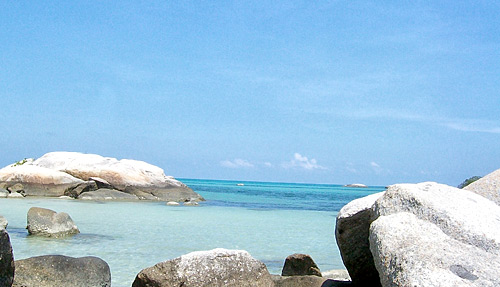 Actually, Punai beach has not known yet as tourism object. This
beach is kind of natural beach with its white sandy and few of
granites. This beach is located about 93 km of Tanjung Pandan or 18 km
of Dendang District. It is about 11/2 hour of Tanjung Pandan. Punai
Beach is stay at end south side of Belitung Island. This beach is also
the place of the fishermen to looking for fresh fish. So, the visitors
can enjoy fresh fish from the fishermen. This beautiful beach is
suitable for having sport activities, such as swimming, fishing and also
snorkeling.
Actually, Punai beach has not known yet as tourism object. This
beach is kind of natural beach with its white sandy and few of
granites. This beach is located about 93 km of Tanjung Pandan or 18 km
of Dendang District. It is about 11/2 hour of Tanjung Pandan. Punai
Beach is stay at end south side of Belitung Island. This beach is also
the place of the fishermen to looking for fresh fish. So, the visitors
can enjoy fresh fish from the fishermen. This beautiful beach is
suitable for having sport activities, such as swimming, fishing and also
snorkeling. Because it’s natural beach, Punai beach can fresh your mind and make you feel comfort in spend your trip here. It is also suitable for the adventurer to get their different adventurous.
Langganan:
Komentar (Atom)